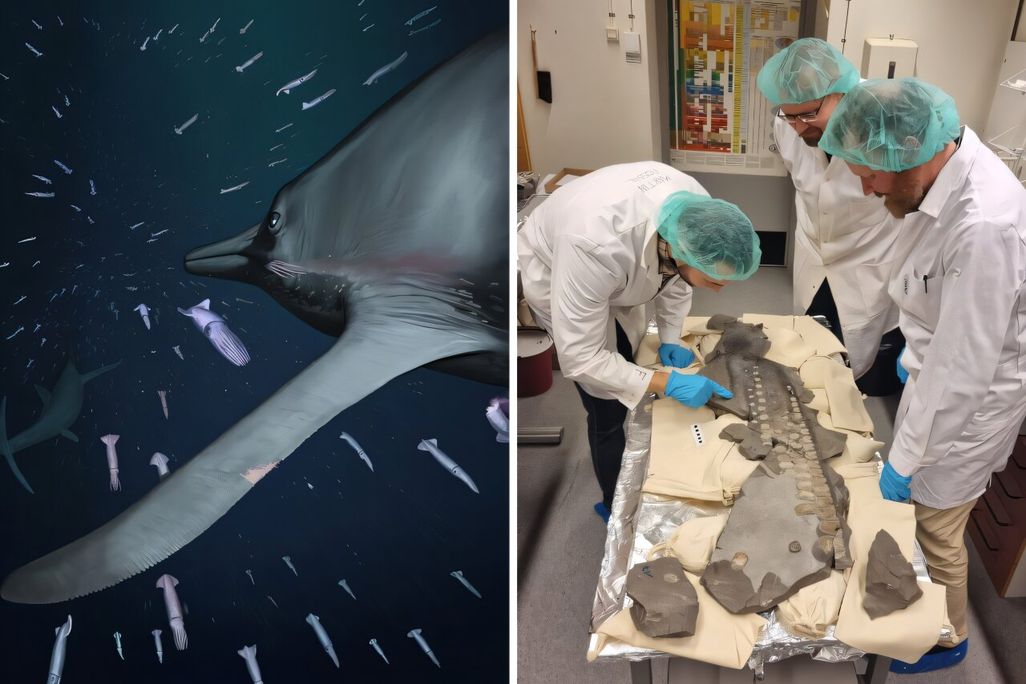Fossil Flipper Reveals Ichthyosaurs Hunted in Lethal Silence With Unique Adaptations for Stealth
An analysis of a roughly 180-million-year-old fossil fin reveals serrations and flexibility that might have served to dampen sound as the predator swam

While dinosaurs ruled the land, large ichthyosaurs stalked their prey across prehistoric oceans—and according to new research, they hunted in lethal silence.
Scientists analyzed a well-preserved, roughly 183-million-year-old fossilized flipper from Temnodontosaurus—a giant ichthyosaur—and discovered it was uniquely adapted to minimize sound. Their findings were published in the journal Nature on July 16.
“Ichthyosaurs have fascinated scientists for over 200 years, but this study shows that there’s still more we can learn about them,” Marc Jones, curator of fossil reptiles at the Natural History Museum in London (NHM) who was not involved in the study, tells the museum’s James Ashworth.
Fun fact: The first ichthyosaur discovery
British paleontologist Mary Anning identified the first known ichthyosaur fossil. Her brother, Joseph, found the skull around 1811, when Mary was 12. She dug out the rest of the bones over several months.
To their surprise, the scientists found that the trailing edge of the ichthyosaur’s meter-long flipper was serrated rather than smooth. The serrations included cartilage reinforced by calcium, forming previously unseen strengthening structures the team named chondroderms.
To better understand how the flipper moved through water, they created computer models combined with previous knowledge of ichthyosaur swim speeds to simulate the animal’s motion. The serrations, along with the winged shape of the flipper, would have helped the predator move soundlessly, they suggest in the study.
The fleshy tip of the flipper didn’t have any bones—it contained only cartilage. This also would have helped the animal move more efficiently, kind of like the upward-pointing winglets on the tips of commercial airplane wings, which help reduce drag.
“The way that water moves over the surface of the flipper causes rotating vortices to form, which cause drag,” explains lead author Johan Lindgren, a paleontologist at Lund University in Sweden, to NHM. “By flexing the fin this tip would act like a winglet, changing how the water flows and reducing this impact.”
/https://tf-cmsv2-smithsonianmag-media.s3.amazonaws.com/filer_public/54/43/54438a66-a03c-4dd5-a4a0-163f11c12b2a/image1-2.jpg)
The fossil was first discovered by collector Georg Göltz, now a co-author of the study. He stumbled upon fragments of it while looking for fossils at a road construction site in the municipality of Dotternhausen, Germany, in 2009. Göltz brought the fossil to paleontologist Sven Sachs at the Natural History Museum in Bielefeld, Germany, who is also a study co-author.
Eventually, the specimen made its way to Lindgren in Sweden and remained untouched in his laboratory for a few years, until he decided to take a closer look. He successfully assembled the fragmented pieces into the shape of a flipper.
These giant ichthyosaurs had anatomy akin to the owls of today, Lindgren says in a statement. Owls can fly silently thanks to fringe-like serrations formed at the trailing edge of their feathers. The similarities don’t end there: Temnodontosaurus had giant eyes—the biggest of any animal ever—a trait shared with owls that would have helped the animals hunt in dim environments, reports Carolyn Gramling at Science News.
“The soft tissue preservation in this fossil is just one of these amazing discoveries that you stumble across once in a lifetime, perhaps,” Lars Schmitz, a paleontologist at Claremont McKenna College who wasn’t involved in the study, tells Lauren Leffer at Popular Science. He adds that the researchers’ approach was thorough. “It’s a really unique and very interdisciplinary analysis, with a whole array of innovative techniques.”
However, he notes that the features described in the research could have first evolved for speed rather than sound dampening. Further research could provide alternative explanations for the findings, he adds.
The study “shows how little we know about ancient animals,” Lindgren tells Science News. “I had no idea this is where we would end when I started off [with this fossil] three years ago. It kind of blows my mind.”
Also this year, scientists published an analysis of another rare, fossilized ichthyosaur flipper preserved with soft tissues intact. This revealed both smooth and scaly skin, which would have helped the animal move through the water.
There could still be even more to discover: Schmitz hopes that the new study inspires other scientists to revisit other fossils and maybe spark a reevaluation of today’s marine animals, too.
The discovery could reach beyond the ocean, as well. Similar structures to those uncovered in the ichthyosaur could help engineers reduce sound in their devices, building quieter propellers and hydrofoils, Lindgren tells NHM, which might help address the problem of underwater noise pollution.
/https://tf-cmsv2-smithsonianmag-media.s3.amazonaws.com/accounts/headshot/Sara_-_Headshot_thumbnail.png)
